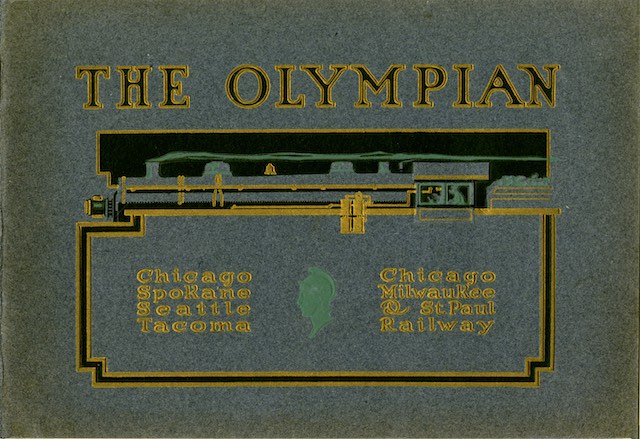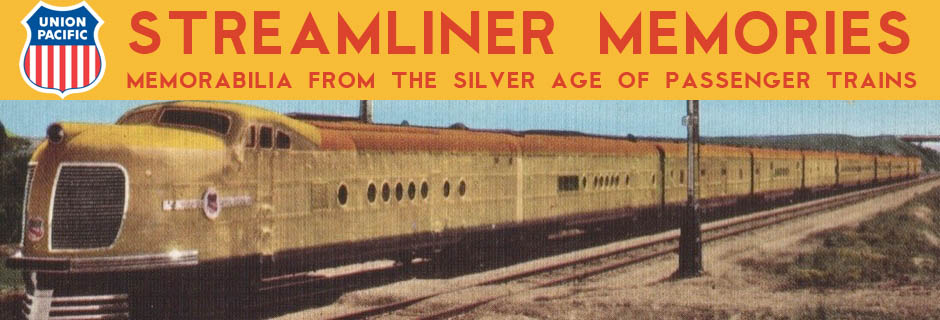A few months ago I presented a 1912 booklet about the Olympian. This booklet is similar but, based on the list of agents in the back, I date it to 1913. It is worth noting that, in November, 1915, the railroad operated its first electrically powered locomotives between Three Forks and Deer Lodge, Montana, and since this booklet doesn’t mention that momentous event, it is clearly from before that date.

Click image to download a 27.2-MB PDF of this 24-page booklet.
Like the 1912 booklet, today’s booklet illustrates the trains with several photographs, the first one of which shows the dining car of the Olympian. There are no people in this or any of the other interior photos, while the 1912 booklet shows dining car staff and the 1911 booklet presented here yesterday shows both staff and passengers. The presence of the passengers makes it seem much more inviting so I have to wonder why the photo in today’s booklet is so sterile by comparison.
The 1911 and 1912 booklets both also show the Olympian‘s observation car with the rear platform crowded with sightseers. For some reason, that got left out of today’s booklet. The text in this booklet is similar but not identical to that of the 1912 booklet (but both are very different from the 1911 edition), but the scenic photographs in this booklet are all different. The photo of Eagle’s Nest Tunnel on page 13 of today’s booklet was taken from almost the same spot as one on page 19 of the 1912 booklet, yet they are two different photos.
The main photos in the 1912 booklet are accompanied by a series of side illustrations that appear to be drawings. Interior photos are accompanies by interior drawings and scenic photos have drawings of scenic areas. The railroad probably didn’t pay the illustrator enough so it had to repeat some of the illustrations.
The same pattern is followed in today’s 1913 booklet, but each page has two side illustrations. Again, interior illustrations accompany interior photos why scenic illustrations accompany scenic photos. A total of just six interior illustrations and four scenic illustrations are used, so the interior illustrations are repeated three times and the scenic ones five times.
The cover of the 1913 booklet is the most distinctive thing about it. The 1912 cover just has the words “The Olympian” in large letters, but today’s has the profile of the upper half of a steam locomotive, with plenty of gilt for the words and various decorations. A comparison of this locomotive profile with locomotive 1505 shown on page 16 of the 1912 booklet reveals they are identical, both representing one of the Milwaukee’s latest 4-6-2 engines.
Locomotive 1505 was built by Alco in 1910 and its 79″ drivers produced almost 32,000 pounds of tractive effort, making it far more powerful than the 4-4-0 and 4-4-2 locomotives that preceded it, and even many of the earlier 4-6-2 locomotives. A 4-6-0 built for the St. Paul road in 1907 and a 4-4-2 built for the railroad in 1909 each produced a little more than 25,000 pounds of tractive effort. While the 1505 wasn’t superheated when it was built, superheaters were added later, allowing the railroad to increase the size of the cylinders slightly and bumping its tractive effort up by another 1400 pounds.
From a marketing viewpoint, steam locomotives would become irrelevant to the Olympian after 1915, when the St. Paul started using electric locomotives. This was just one more step in the railroad’s efforts to maintain technological superiority over its rivals.

IIRC, electrification of the Pacific Extension ended up costing three time what was originally budgeted. Bad luck, bad timing, or maybe some of both.
By the same token, in the late 1970s Milwaukee was unable to maintain the electrified portions of the line and began using diesel power instead. Again, bad luck because they could have used the electrified lines to gain some competitive advantage while the BN was grappling with high diesel fuel costs.